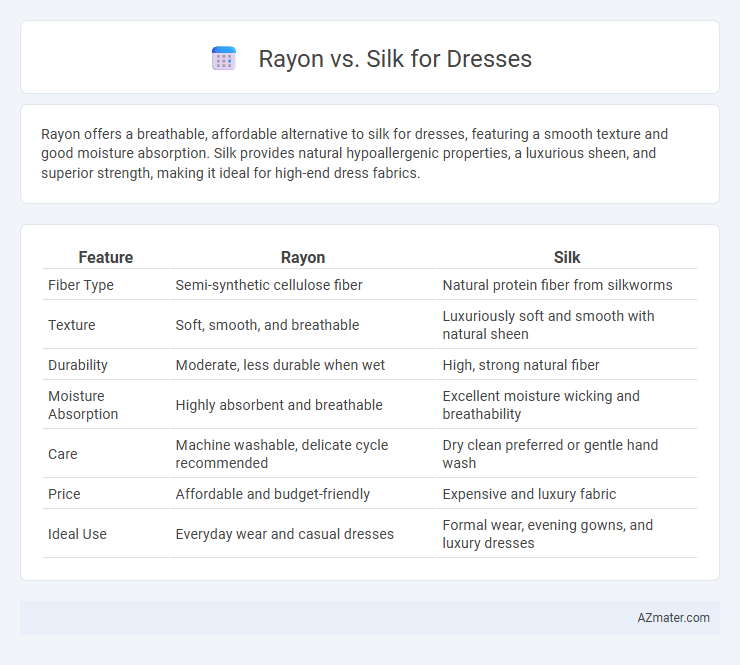Rayon offers a breathable, affordable alternative to silk for dresses, featuring a smooth texture and good moisture absorption. Silk provides natural hypoallergenic properties, a luxurious sheen, and superior strength, making it ideal for high-end dress fabrics.
Table of Comparison
| Feature | Rayon | Silk |
|---|---|---|
| Fiber Type | Semi-synthetic cellulose fiber | Natural protein fiber from silkworms |
| Texture | Soft, smooth, and breathable | Luxuriously soft and smooth with natural sheen |
| Durability | Moderate, less durable when wet | High, strong natural fiber |
| Moisture Absorption | Highly absorbent and breathable | Excellent moisture wicking and breathability |
| Care | Machine washable, delicate cycle recommended | Dry clean preferred or gentle hand wash |
| Price | Affordable and budget-friendly | Expensive and luxury fabric |
| Ideal Use | Everyday wear and casual dresses | Formal wear, evening gowns, and luxury dresses |
Introduction to Rayon and Silk
Rayon is a semi-synthetic fiber made from regenerated cellulose, known for its smooth texture and breathability, making it a popular choice for lightweight dresses. Silk, a natural protein fiber produced by silkworms, offers a luxurious sheen, exceptional softness, and excellent moisture-wicking properties ideal for elegant and comfortable dresses. Both fabrics provide unique benefits, with rayon often favored for affordability and versatility, while silk is prized for its premium quality and durability.
Origins and Production Processes
Rayon is a semi-synthetic fiber derived from cellulose sources like wood pulp, undergoing chemical processing that regenerates natural polymers into fabric, while silk originates from natural protein fibers produced by silkworms during cocoon spinning. The production of rayon involves dissolving cellulose and extruding it through spinnerets to form fibers, a process largely industrial and scalable, whereas silk production requires painstaking sericulture, harvesting cocoons, and reeling fine threads manually or mechanically. Both materials reflect distinct origins--rayon's blend of nature and chemistry contrasts with silk's purely biological genesis, impacting texture, strength, and environmental considerations in textile manufacturing.
Texture and Feel Comparison
Rayon offers a smooth, soft texture that mimics the luxurious feel of silk but tends to be cooler and more breathable, making it ideal for warmer climates. Silk provides a naturally lustrous, silky-smooth surface with a unique softness that feels gentle against the skin and drapes elegantly on the body. The choice between rayon and silk for a dress largely depends on the desired balance between affordability, comfort, and the natural sheen characteristic of silk fabrics.
Breathability and Comfort
Rayon offers excellent breathability and moisture absorption, making it a comfortable choice for warm weather dresses, as it allows air circulation and helps keep the wearer cool. Silk, while luxurious and smooth, provides moderate breathability but tends to trap heat and moisture more than rayon, which can reduce comfort in hot, humid conditions. Both fibers deliver softness, but rayon's ability to wick moisture and promote airflow makes it superior for breathable, comfortable dress fabrics.
Appearance and Visual Appeal
Rayon offers a smooth, shiny finish that closely mimics silk, providing an affordable yet elegant look for dresses. Silk's natural luster and subtle iridescence create a luxurious visual appeal that changes with light angles, enhancing its richness and depth. While rayon can achieve vibrant colors and drapes well, silk maintains superior sheen and softness that elevate the overall sophistication of the garment.
Durability and Longevity
Rayon fabric, made from regenerated cellulose fibers, generally offers moderate durability but tends to weaken when exposed to water and frequent washing, leading to reduced longevity. Silk, a natural protein fiber produced by silkworms, is renowned for its exceptional strength and resilience, maintaining its luster and structural integrity over time with proper care. While silk garments often outlast rayon dresses, both fabrics require delicate handling to preserve quality and extend their wearable lifespan.
Care and Maintenance Requirements
Rayon dresses require gentle hand washing or dry cleaning due to their sensitivity to water and tendency to shrink, while silk dresses need delicate handling with mild detergents and preferably dry cleaning to maintain their luxurious texture and sheen. Both fabrics should be air-dried away from direct sunlight to prevent discoloration and damage. Storing rayon and silk dresses in breathable garment bags helps protect fibers from moisture and pests, prolonging garment life.
Environmental Impact and Sustainability
Rayon production involves significant chemical use and deforestation, contributing to environmental pollution and habitat loss, whereas silk, derived from silkworms, relies on natural processes but requires intensive labor and resources. Both fibers pose sustainability challenges: rayon's manufacturing impacts water and air quality, while silk's production demands substantial energy and ethical considerations regarding animal welfare. Choosing eco-friendly alternatives or certified sustainable sources can lessen the environmental footprint of garments made from either material.
Price and Accessibility
Rayon offers a cost-effective alternative to silk, making it more accessible for budget-conscious consumers seeking stylish dress fabrics. Silk, known for its luxurious texture and natural sheen, commands a higher price due to its labor-intensive production and premium quality. The wide availability of rayon in various blends and colors contributes to its popularity in affordable dress options compared to the exclusive nature of genuine silk garments.
Choosing the Best Fabric for Your Dress
Rayon offers a soft, breathable texture ideal for affordable, lightweight dresses, while silk provides a luxurious, smooth feel with natural sheen and better moisture-wicking properties. Choosing the best fabric depends on your preference for durability, maintenance, and occasion; silk excels in elegance and longevity, though rayon is easier to care for and more budget-friendly. Consider factors like climate, fabric weight, and desired drape to ensure your dress meets comfort and style requirements.

Infographic: Rayon vs Silk for Dress
 azmater.com
azmater.com